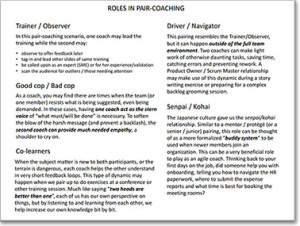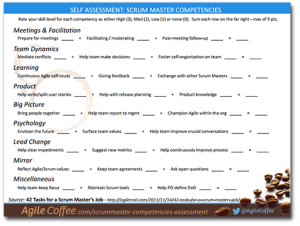
Back in March I led a pair coaching workshop at Scrum Day Orange County 2015. My goal with the session was to examine a few pair-coaching roles, share a list of competency areas for Scrum Masters, and use dominoes to demonstrate viable situations where pairing will help the coach, her team, or the larger organization.
(You may remember that I enjoy exploring this topic, and that I wrote about it earlier in the year. It seems that I’ll be talking about more this summer at the Scrum Alliance Coaching Retreat, possibly at the Agile Open SoCal and certainly at Agile SoCal in November.)
No matter how good we are, we still can’t learn or do everything on our own. Whether you’re a Scrum Master, product owner or other member in an Agile workplace, you should consider using pair-coaching to raise your skill level, create positive change on your teams and improve relationships throughout the organization.
When I was approached to make a presentation on pair-coaching, I began asking around for comments. It was important to me that participants left with something tangible and valuable. I began building the content as a powerpoint deck, but early feedback (and my post-lunch time slot) suggested an interactive workshop made more sense.
Roles in Pair-Coaching
 The goal of the workshop was to get participants thinking in terms of the many ways to use pair-coaching at the workplace. To do this, it was important to share the five pairing roles that I previously discussed:
The goal of the workshop was to get participants thinking in terms of the many ways to use pair-coaching at the workplace. To do this, it was important to share the five pairing roles that I previously discussed:
- Trainer / Observer
- Driver / Navigator
- Yin / Yang (I’ve renamed this role from “Good Cop / Bad Cop”)
- Kohai / Sempai
- Co-Learners
By introducing the five roles, I was able to give specific contexts in which to imagine using pair-coaching. (The handout above offers a summary of the five roles.)
* I owe much to Yves Hanoulle, a true creative collaboration agent, for his work identifying most of these roles (I am really just mucking with them). Yves has been a strong proponent of pair-coaching for many years, and most of the research I do on the subject turns up his name.
ScrumMaster Assessment
While I’m giving credit to others who deserve it much more than me, I’d like to call your attention to Bernd Schiffer’s excellent article on the 42 Tasks of a Scrum Master’s job. I find his list quite comprehensive and very useful when talking about pair-coaching.
 This assessment I put together was taken primarily from Bernd’s list of 42 tasks, though I overlaid the “grading” rubric to meet the needs of this game. (A big thanks to Fabrice Aimetti for translating this into french: Evaluation des compétences du Scrum Master.)
This assessment I put together was taken primarily from Bernd’s list of 42 tasks, though I overlaid the “grading” rubric to meet the needs of this game. (A big thanks to Fabrice Aimetti for translating this into french: Evaluation des compétences du Scrum Master.)
In the workshop, I ask the participants to give themselves a grade for each competency – from “0” equating to “no experience” to “3” meaning “expert”. They can sum the numbers across each row (competency group) to gauge what areas of coaching they’re good at and which could use improvement. (The point isn’t to be too critical here, but to have some grounding for the game.) The range of row-scores is zero (0) to nine (9), identical to the range of numbers on my dominoes.
Rules of the Game
Finally we get to the game itself. Each participant has a double-nine domino tile at their seat when they come in the room. They are asked to match one of their numbers to pair with another participant – this is done to get them out of their chairs and meet “random” people in the room. Example, if my domino has a two (2) and a five (5), I find another person with either of those digits.
When they form pairs (eg. both have a five (5) on their domino), they assume expertise levels based on the other number not used to match up. In my two and five scenario, I would use two (2) as my expertise level because I used the five (5) to meet another five. (It’s a pain to explain, but participants caught on quickly.)
Each pair then talks through a case of which roles they might play for a hypothetical scenario. For example, if a “two” (novice) is paired with an “eight” (expert), they might play out a Driver / Navigator situation. If the numbers are close but low (eg, 3 & 2), the scenario might be Co-Learners; and a 7 & 9 combo may yield a Good Cop / Bad Cop storyline.
Let me say that this early iteration of the game could certainly use some adjustment. I’m open to feedback even to the point of removing the dominoes altogether. Having said that, however, it seemed to work very well to stimulate role-playing and discussion in the workshop. So… success!
Below is a video of the session. The workshop begins by reviewing the five roles, and we start playing with dominoes approximately 22 minutes into the video. I am again grateful to Scott Dunn of Rocket Nine Solutions for the support, and to Cliff Rosa of Rosa Media Productions for the recording – thanks to you both!
I hope that you try this game and I welcome feedback in the comments here on this page or to me on Twitter at @AgileCoffee. Best of luck in your pairing!

